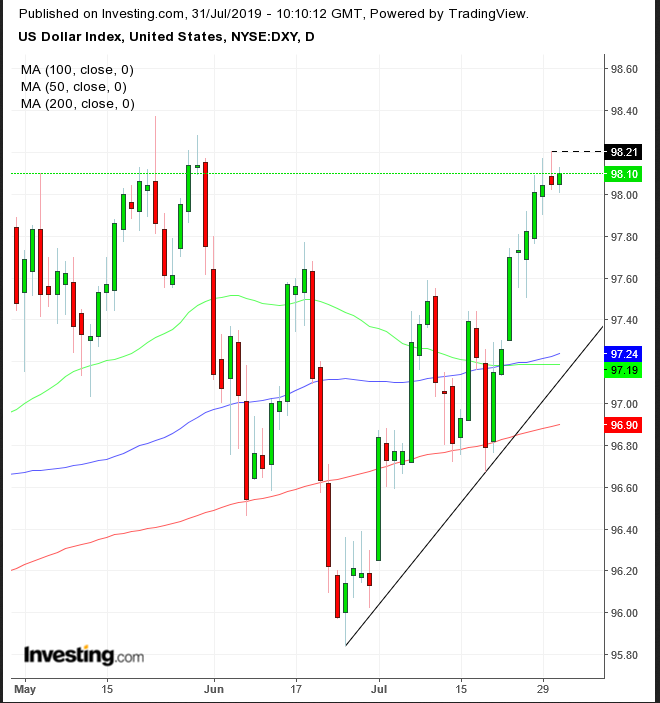U.S. stocks rise on Fed cut bets; earnings continue to flow
If the Fed is going to cut rates, why is the U.S. dollar enjoying its strongest rally in almost three years?
More than 78% percent of traders bet that the Fed will cut its benchmark rate for the first time in a decade by 25 basis points to 2.25. Yet, traders couldn’t get enough of the dollar, pushing it up for nine straight days in its longest rally since the 10-day advance when President Donald Trump took the White House by storm.
So, why is the greenback not plunging in anticipation of the first rate cut since before the Financial Crisis? The first cut after nine increases since December 2015 should logically weigh on the dollar, not boost it so much that the length of its rally competes with that of the so-called Trump Trade.
But of course, a currency trade doesn't take place in a vacuum, as its strength is measured relative to other currencies. And, however dovish the Fed might suddenly be, it still lags well behind other major central banks, both in time and degree.
In a bond market deluged with negative yields, the 10-year Treasury yielding 2% is a godsend, attracting substantial foreign demand, who must buy the dollar first. Europe is hit with weak growth and Brexit uncertainty weighs both on the euro and the pound, which is near a two-and-a-half year low, teetering above the lowest since 1985.
And this is if the Fed does give in to market pressure and President Donald Trump. If it surprises and doesn’t cut, the dollar will soar.
However, before rushing into a dollar position, traders should be aware that the greenback faces substantial resistance.

The dollar’s trading pattern yesterday formed a shooting star, demonstrating an increase in supply, at the loaded levels of the April and May highs.
Also, while its rally is the longest since November 2016, the move’s strength pales in comparison. The greenback advanced 4.3 percent Nov. 4-18 2016. Now, only 1.3%, a much lower percentage, even though the price is lower. And it's still below the advance of that time.
Therefore, we’d advise “patience,” just as Powell did before his flip-flop, and wait for a pullback before entering a long position. Aggressive traders may enter a trade contrarian to the trend but not the market sentiment surrounding the Fed cut consensus, before joining smart money in a long position.
Trading Strategies
Conservative traders might wait on a long position for a full corrective move as savvy investors who traded on the rumors and are about to sell on the anticipated Fed cut news take profits.
Moderate traders might be content with a pullback to 97.60, the previous high posted on July 9, with a stop-loss below 97.40 and the uptrend line.
Aggressive traders could risk a short position, counting on the return move toward the uptrend line.
Trade Sample
